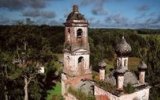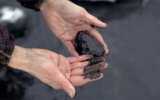Photo: the terrible scars on the body of the Earth — the work of human hands
What we humans do with their planet, especially in those places that are so well able to choose for your picture of renowned canadian photographer Edward Burtynsky.
Наверх11фотографий11фотографий11фотографий
Canadian — master to depict post-industrial landscapes so that they look surreal and frightening: “indelible mark that humanity leaves on the geological face of the Earth.”
His images leave, to put it mildly, mixed feelings. He usually makes them with a helicopter, and then from the satellite. First you admire the opened picture, and then I realize — this documentary is something sinister.
News Deserted village, skeletons of churches and the Russian destruction as works of art
Deserted village, skeletons of churches and the Russian destruction as works of art
His large-format photography is a kind of aesthetic quality such seemingly unaesthetic things, like mining, deforestation, industrial landfills, monumental piles of garbage, plastic, rubber, discarded equipment…
Photographer shows it to such an extent that its scenery look like the crystal forms, and human activity with the proposed Burtynsky point resembles creeping mold, infectious fungus on the body of the planet.
“Most will pass by the dump and don’t even think it can be great to photograph, once said Burtynsky. But in such places you can always make a good shot, you only need to search”.
In one of his famous series depicted the mountains of old tires in California. Another mountain burnt ivory seized from poachers. The third monstrous wave-like curves developed by the man of rock on one of the world’s largest open-pit mines, where the mined copper ore…
In this radically antidirector vision of the world is a kind of grim irony.
Nobel laureate Paul Josef Crutzen, author of the theory of nuclear winter, in 2000, proposed (together with Eugene Stormer) the term “anthropocene” to describe the present geological era as the era dominated by human activities.
News “we’ve Got Syria”: what is life like near coal mines
“we’ve Got Syria”: what is life like near coal mines
As part of its new multimedia project “the Anthropocene,” Burtynsky for five years and traveled 20 countries. He believes that “we are one step away from becoming guilty in the largest destruction of the environment (if not already become)”.
And in his pictures it shows extremely clearly: for example, in an unnatural color waste phosphorus in waterbodies of those areas where they are developing phosphate needed in agriculture. As a rule, in such places it is impossible to restore nature after pollution.